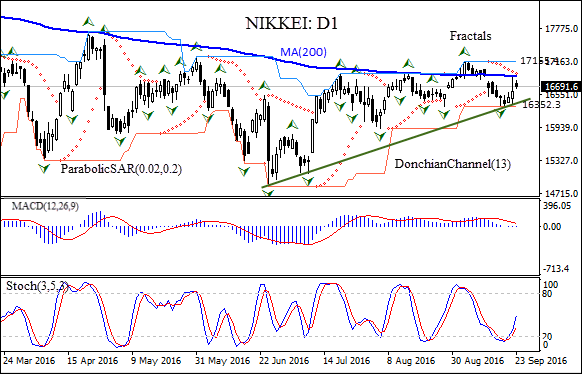Bank of Japan monetary stimulus program extension may lift Nikkei
The Bank of Japan left the deposit rate at minus 0.1% at September 21 policy meeting but stated it will continue quantitative easing program until the inflation overshoots the 2% inflation target. Will Nikkei continue rising?
The Japanese GDP expanded 0.2% in the second quarter over the previous quarter, slowing from 0.5% quarterly rate in the first quarter. The government unveiled a new budget with expanded fiscal spending measures of JPY 28.1 trillion ($269 billion) to stimulate the economy in addition to existing monetary program of quantitative easing. The focus of the adopted spending measures was the reconstruction in earthquake-hit areas and infrastructure projects. Data show the economy expanded in the second quarter as fixed capital investment increased, with private consumption and contribution from external trade steady. Recent reports indicate continued growth in following months too: capital spending expanded in July with core machinery orders ring 4.9% over the previous month, following a 8.3% growth in June. While industrial production was flat in July after a 2.3% increase in June, another positive development was improvement in consumer confidence with consumer sentiment rising in August to 42.0 from 41.3 in July. For export oriented Japanese economy with stagnant domestic demand the pace of economic growth depends strongly on external demand. And despite a massive quantitative easing program Japanese yen is rising, negatively impacting competitiveness of Japanese exporters and limiting growth. At the same time the Bank of Japan left the deposit rate at minus 0.1% at September 21 policy meeting but stated it will continue asset purchases of quantitative easing program until the inflation overshoots the 2% inflation target. While the size of annual asset purchases was not increased the extension of asset purchases will provide continued increase in liquidity which is bullish for growth and asset prices.
On the daily chart the NIKKEI: D1 has been rising since end of June. The price is edging toward the 200-day moving average.
The Donchian channel indicates no trend yet: the channel is flat.
The Parabolic indicator gives a sell signal.
The MACD indicator is below the signal line and the gap is narrowing, which is a bullish signal.
The stochastic oscillator is rising and hasn’t reached the overbought zone.
We believe the bullish momentum will continue after the price closes above the fractal high at 17155.4. A pending order to buy can be placed above that level. The stop loss can be placed below the last fractal low at 16352.3. After placing the pending order the stop loss is to be moved every day to the next fractal low, following Parabolic signals. Thus, we are changing the probable profit/loss ratio to the breakeven point. More conservative traders can switch to the 4-hour chart and move the stop-loss in the direction of the trade. If the price meets the stop loss level(16352.3) without reaching the order(17155.4), we recommend cancelling the position: the market sustains internal changes which were not considered.
Technical Analysis Summary
Position Buy
Buy stop Above 17155.4
Stop loss Below 16352.3
This overview has an informative character and is not financial advice or a recommendation. IFCMarkets. Corp. under any circumstances is not liable for any action taken by someone else after reading this article.
Recommended Content
Editors’ Picks
EUR/USD clings to gains above 1.0750 after US data

EUR/USD manages to hold in positive territory above 1.0750 despite retreating from the fresh multi-week high it set above 1.0800 earlier in the day. The US Dollar struggles to find demand following the weaker-than-expected NFP data.
GBP/USD declines below 1.2550 following NFP-inspired upsurge

GBP/USD struggles to preserve its bullish momentum and trades below 1.2550 in the American session. Earlier in the day, the disappointing April jobs report from the US triggered a USD selloff and allowed the pair to reach multi-week highs above 1.2600.
Gold struggles to hold above $2,300 despite falling US yields

Gold stays on the back foot below $2,300 in the American session on Friday. The benchmark 10-year US Treasury bond yield stays in negative territory below 4.6% after weak US data but the improving risk mood doesn't allow XAU/USD to gain traction.
Bitcoin Weekly Forecast: Should you buy BTC here? Premium

Bitcoin (BTC) price shows signs of a potential reversal but lacks confirmation, which has divided the investor community into two – those who are buying the dips and those who are expecting a further correction.
Week ahead – BoE and RBA decisions headline a calm week

Bank of England meets on Thursday, unlikely to signal rate cuts. Reserve Bank of Australia could maintain a higher-for-longer stance. Elsewhere, Bank of Japan releases summary of opinions.
